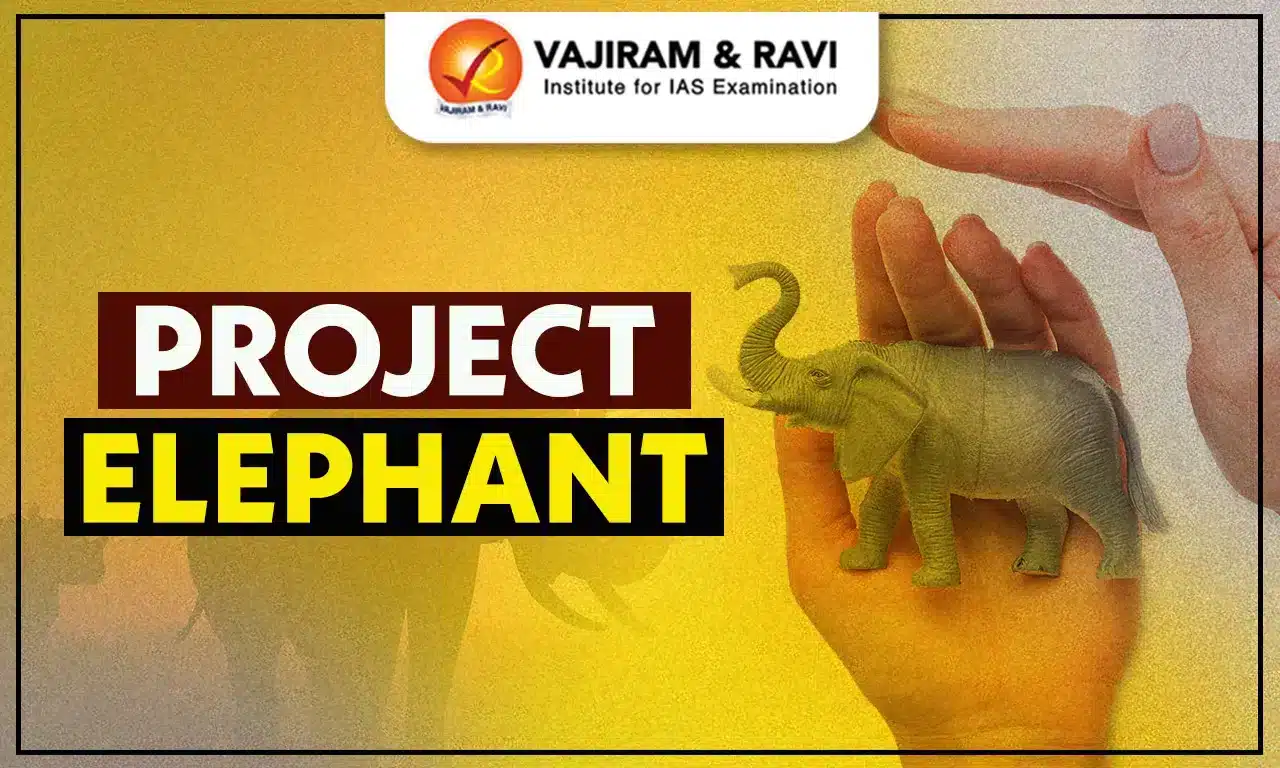Project Elephant was launched by the Government of India’s Ministry of Environment and Forests in February 1992. It’s a scheme aimed at supporting states in managing their wild Asian elephant populations through financial and technical assistance.
Recent News:
- The government has notified the Captive Elephant (Transfer or Transport) Rules, 2024, easing conditions for elephant transfers.
- Captive elephants are under strict regulations, considering their historical roles and significance.
- Translocation of captive elephants is permitted for special purposes like education and scientific research, subject to wildlife protection regulations.
Asian Elephants
India boasts the largest and most stable population of Asian elephants, with over 60% of all wild Asian elephants calling it home. The most recent elephant census conducted in 2017 recorded a total of 29,964 elephants.
Additionally, India houses 31 elephant reserves, including recent additions like the Dandeli Elephant Reserve in Karnataka, the Singphan Elephant Reserve in Nagaland, and the Lemru Elephant Reserve in Chhattisgarh. This expansion has led to approximately 76,508 square kilometres of elephant reserves spread across 14 states in India.
According to the 2017 Elephant Census, Karnataka holds the highest number of elephants, with 6,049 individuals, followed by Assam with 5,719, and Kerala with 3,054.
Species of Asian Elephants
Asian elephants are categorised into three subspecies: the Indian, Sumatran, and Sri Lankan.
- As the largest terrestrial mammal in Asia, Asian elephants inhabit grasslands and forests across 13 countries in South and Southeast Asia, adapting to various environments from dry to wet.
- Compared to African savannah elephants, Asian elephant herds are notably smaller in size.
- Within elephant herds, the largest and oldest female, known as the matriarch, assumes leadership and decision-making responsibilities.
- Asian elephants have the longest known gestational period among mammals, lasting up to 680 days (22 months).
- Female elephants typically give birth to calves every four years between the ages of 14 and 45. This interval increases to five years by age 52 and six years by age 60.
- Throughout Asia, elephants hold significant cultural importance and have a long history of close association with humans, evolving into symbolic figures in various cultures.
Protection Status of Asian Elephants
- IUCN Red List: Endangered.
- Wildlife (Protection) Act, 1972: Schedule I.
- CITES: Appendix I
Objectives of Project Elephant Simplified
- Conservation Planning: Create and promote smart plans to protect elephants using science.
- Combat Illegal Trade: Stop the illegal buying and selling of elephant tusks and shield elephants from hunters and poachers.
- Prevent Deaths: Develop ways to stop unnatural causes of elephant deaths in India.
- Restore Habitats: Bring back the natural homes of elephants and the paths they travel.
- Reduce Conflict: Lower fights between people and elephants in areas where they both live.
- Limit Human Activities: Cut down on people and their animals moving into places where elephants live.
- Support Research: Encourage studies on elephant protection and spread awareness about them.
- Healthcare: Make sure domestic elephants get the right care to stay healthy and help them breed properly.
- Community Development: Help communities living near elephants to grow in a way that’s good for both people and elephants.
Threats to Elephants
The threats to elephants in India are numerous and have significant impacts on their populations and habitats. Here are the primary threats:
- Habitat Loss and Fragmentation: The expansion of human settlements and economic development has led to a significant loss and fragmentation of elephant habitats. This not only reduces the space available for elephants but also disrupts their migratory patterns.
- Human-Elephant Conflict: As habitats shrink, elephants often raid plantations and crop fields in search of food, leading to conflicts with humans. These conflicts can result in the death and injury of both humans and elephants.
- Poaching: Elephants are targeted by poachers for their ivory, meat, and other body parts. Poaching has led to a skewed male-female ratio in many areas, especially since only male Asian elephants have tusks.
- Other Challenges: Elephants also face accidental deaths due to train collisions, electrocutions, harm from crude bombs intended for other animals, and falls into pits or trenches.
Efforts to mitigate these threats include habitat conservation, reducing human-elephant conflict, and stricter enforcement against poaching. Conservation organizations and the government are working together to ensure the survival of these majestic creatures.
Measures Taken for Conservation
The Indian government has implemented several measures for elephant conservation and protection, focusing on both the animals and their habitats:
- Project Elephant: Launched in 1992, this initiative aims to conserve elephant populations and their habitats, reduce human-elephant conflicts, and improve the welfare of captive elephants.
- Habitat Restoration: Efforts are made to restore elephant habitats and corridors to ensure safe migration routes for elephants across different states.
- Anti-Poaching Measures: Establishment of anti-poaching squads, increased patrolling, and rewards for information on poachers are some of the steps taken to combat illegal hunting.
- Conflict Mitigation: The government promotes eco-development, public education, and awareness programs to mitigate human-elephant conflicts. Deployment of anti-depredation squads and scientific management of elephant populations are also part of these efforts.
- Legal Protection: Elephants are protected under Schedule I of the Indian Wildlife (Protection) Act, 1972, which prohibits their hunting and trading.
- Ex-Gratia Payments: Compensation is provided to families affected by human-elephant conflicts, which helps in fostering coexistence.
- Disease Prevention: Measures are taken for the detection and prevention of diseases in wild elephants to maintain their health and well-being.
These measures reflect the government’s commitment to preserving the elephant population and ensuring their survival for future generations.
Project Elephant remains crucial for safeguarding India’s elephant population. With concerted efforts and regulatory measures, conservation initiatives aim to mitigate threats and ensure the well-being of these majestic animals.
Last updated on December, 2025
→ Check out the latest UPSC Syllabus 2026 here.
→ Join Vajiram & Ravi’s Interview Guidance Programme for expert help to crack your final UPSC stage.
→ UPSC Mains Result 2025 is now out.
→ UPSC Notification 2026 is scheduled to be released on January 14, 2026.
→ UPSC Calendar 2026 is released on 15th May, 2025.
→ UPSC Prelims 2026 will be conducted on 24th May, 2026 & UPSC Mains 2026 will be conducted on 21st August 2026.
→ The UPSC Selection Process is of 3 stages-Prelims, Mains and Interview.
→ UPSC Result 2024 is released with latest UPSC Marksheet 2024. Check Now!
→ UPSC Toppers List 2024 is released now. Shakti Dubey is UPSC AIR 1 2024 Topper.
→ Also check Best IAS Coaching in Delhi
Tags: Project Elephant

















